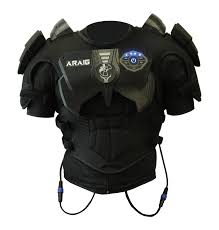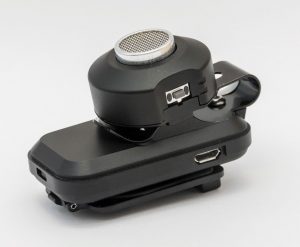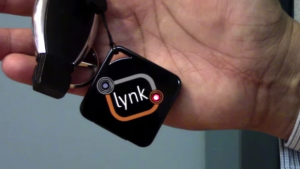
NeuronicWorks rides emergence of IoB designs
Stephen Law
Automation / Robotics Electronics Engineering Software Wireless Contract Manufacturing Engineering IoT Supply Chain Wearable Technology engineering engineering wearable wearableConvergence of wearables and IoT gives birth to Internet of Bodies device sector

As Real AS It Gets (ARAIG) gaming vest, was engineered by NeuronicWorks
The convergence of IoT devices into the wearable electronics’ space has spawned an emerging design sector referred to as the Internet of bodies or IoB. Driven by the merger of personal monitoring technology and advanced wireless communication, IoB represents a significant design opportunity within electronic design circles, according to Titu Botos, VP engineering of NeuronicWorks Inc., a Toronto-based turnkey custom electronic product design company that specializes in hardware, firmware and software development.
Tremendous innovation in personal monitoring and in therapies catering to a ballooning elder care segment of the population has put greater emphasis on IoB healthcare applications. Botos says he has seen the demands rise within his customer base, which ranges from the industrial controls and IoT area to smaller OEMs and/or start-ups that dabble in wearable and consumer electronic designs. “These customers all want to build the next big thing or ‘cool thing’,” says Botos, adding that these “…gadgets will end up on your body, in your pocket or attached to your clothes.”
Botos says IoB devices continue to evolve – from those that measure the body’s blood pressure, heartbeat, movement (speed), etc. as many of these wearable health devices are moving from wristbands and pendants to skin patches, that are worn for 3 or 4 days at a time. This is an area Botos expects will continue to grow and evolve to long lasted patches, along with the more exotic area of implants and ingestible sensors.
IoB devices continue to evolve
Before it was recognized as IoB, athletic and fitness devices debuted with such brands as FitBit, Push, Moov. Today, the market is crowded with startups all the way to well established players like Apple, Garmin and Samsung. Personal care is the other niche market that opened a lot of possibilities for IoB devices. The growing sector of aging baby boomers are now benefitting, as well as their care givers. Some of these devices include ‘trackers’ that can not only remind someone about taking their medicine, but it can also detect a fall and automatically dispatch help, for example.

The BuzzClip, created by iMerciv, is an assistive wearable for people living with blindness or partial sight
At the other end of the spectrum, the second application of IoB personal care is children, including teens, whereby parents can keep track of their whereabouts (via geo-facing) and listen in real time to their surrounding environmental sounds.
The third application of IoB in personal care is remote monitoring of workers in hazardous environments, like mining for example. Here a remote supervisor can talk in real time with the worker, receive a low-resolution-low-frame-rate-image of the worker’s environment and can detect vital signs of his/her body. That tremendously increases safety and makes rescue operations more efficient.
“Besides the coolness factor of having something blinking and buzzing, the other helpful thing is that we are able to sense and monitor in real time what that person is doing/ experiencing, or what happens in the surrounding environment. Always detecting and monitoring what is happening in that environment – around us or to us,” says Botos.
Collaboration amongst the various design departments is key

Lynk is an electronic wallet, that gets attached to your key chain and performs multiple functions.
Emerging from literally a small basement design operation almost 10-years ago with three staff members, today NeuronicWorks Inc. employs 30 engineers along with others in operations. Collaboration amongst the various design departments is key to delivering exactly what the customer wants, according to Botos.
“I don’t believe that we can design in a vacuum. Half of the design comes from the concept of your customer, who is reaching out for that next level of input – from our team of design experts. For us, the magic happens when seated around the same table working on a design, we get conversations between the mechanical, the hardware, the firmware, and the software engineer. Something special happens when we get all of those minds around the table at the same time. That is the moment when the system takes life,” enthuses Botos.
“If they were to conduct their duties at different tables and different time zones, you will often hear a disconnect between design teams, where the message is being lost in translation somewhere. When we work concurrently on the project – together, collaboratively, we get real action through the troubleshooting and actual design process.”
Close-knit team lends itself to a more effective design process
Steering a close-knit team that works together on a regular basis, helps the various and diverse members of the design team learn each other’s strengths and weaknesses – which, in the end, lends itself to a more effective design process, according to Botos.
“Having an open channel with the customer and between ourselves brings trust. Working together over a period of weeks or months on a project develops the lines of trust between all parties. In the end, the customer is the master. We always consider that the customer knows his product and market best, as he is the one who came up with the idea in the first place.”
Deeply entrenched with an altruistic commitment to the electronics ecosystem in Canada, Botos says he seeks to keep almost every aspect of the product design process within Canada, including pcb boards, pcb-assembly, metal forming, cutting and stamping, plastic moulding, fabric all sourced in Ontario – even the boxes that the end product is shipped in. Depending on the level of complexity, Botos remains confident that NeuronicWorks can still get fairly large production runs completed in Canada.
“By the time you add in time, freight, taxes, communication barrier with off-shore manufacturer, heaped with concerns over potential loss of IP, it is simply not worth it in the end,” he says in response to outsourcing production to offshore CEMs.
“We don’t exist in a vacuum – our success is based upon three pillars of support, the Toronto design community, the GTA manufacturing eco-system, and component distribution partners – such Avnet, Arrow, Future Electronics, Astec Components Ltd., Solutions Design Inc., and Symetry Electronics. These disty players play an integral role in keeping our engineers up to speed on the latest technology development.” Botos concludes.
Among some of the wearable devices NeuronicWorks has designed for its OEM customers includes:
Lotus
Personal security device that provides two-way audio communication through your phone to your friend, parent, guardian or assistant. Users who may find themselves in a non-secure environment can reach out for help when needed without fumbling for their phone. The device together with the accompanying app records the sounds around you, as well as track your travels. Device can be either clipped onto clothing or hung around the neck as a medallion.
ARAIG
As Real AS It Gets (ARAIG) gaming vest lets the player feel what is happening to the game character they are playing, as it provides haptic feedback, muscle stimulation, and 7+1 surround sound system on the neck, to enhance gamers’ experience. You can feel the effects of receiving a punch, being stabbed, recoil of firearm discharge, all while hearing the various sounds related to your environment.
Botos says this product helps eliminate some of the criticisms related to virtual reality (VR) gaming, which only focuses on one sense – visual. The vest now connects the body and the ear to the user experience, making it a more natural or real environment.
Domio
The NeuronicsWorks team developed this helmet unit that allows music to be wirelessly delivered via BT from the users’ phone, producing sound through helmet vibration. The novelty of the approach brings with it the increased safety for the wearer. Because the user’s ears are not plugged, they can also hear the surrounding sounds, avoiding dangerous situations while enjoying their beats.
Lynk
Is an electronic wallet, that gets attached to your key chain and performs multiple functions. Working in conjunction with is accompanying app, users can easily chose one of the three privacy settings: home, office and city. Each with more and more demanding spatial constraints, because if the distance between the Link and the phone increase then it begins alarming – thus, avoiding the loss of either phone or keys. In addition, a multiple layered security link is able to securely store user passwords and personal data.
iMerciv
The BuzzClip is an assistive wearable for people living with blindness or partial sight. The device employs ultrasonic technology to detect obstacles that may lie directly in one’s path. It notifies the user of these obstacles through vibrations both in frequency and amplitude, allowing the user to safely navigate his/her path. The BuzzClip offers essential head level obstacle detection and can be easily held or attached to many forms of clothing, making it a highly versatile and useful device.
